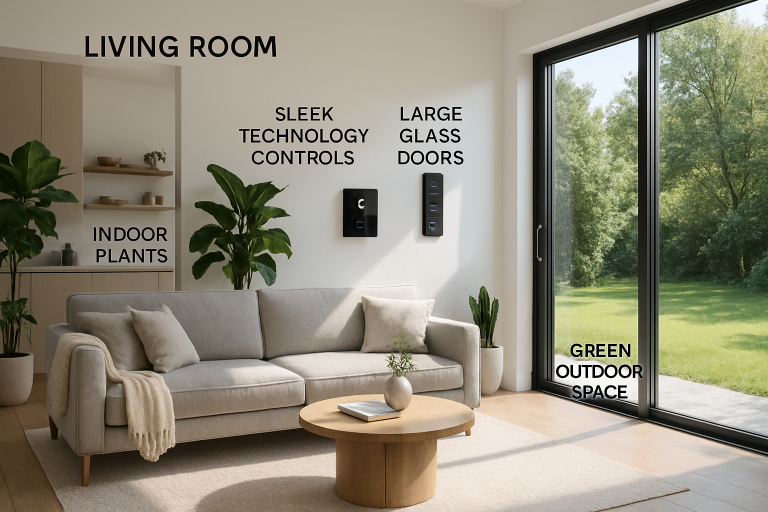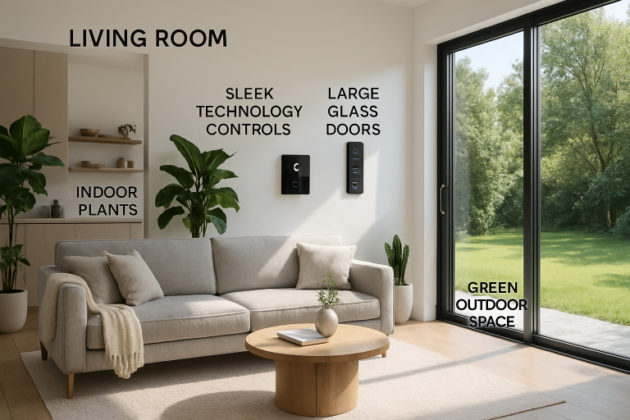Residential architecture is undergoing a transformative evolution, with homeowners prioritizing not only visual beauty but also adaptability, sustainability, and connectivity. This forward-thinking approach is reflected in both interiors and exteriors, giving rise to homes that are attuned to the demands and values of modern life. If you’re interested in seeing how these trends are implemented or are considering your own project, the expertise available in home building Chicago can guide you toward a future-proof space.
Driven by social shifts, technological progress, and a renewed focus on health and the environment, today’s residential designs emphasize adaptable floor plans, smart technology, and personalized details. Let’s explore the innovative trends currently reshaping where and how we live.
Table of Contents
Sustainable and Eco-Friendly Design
Modern home design is increasingly centered on environmental responsibility. From sustainable construction materials to energy-efficient technologies, homeowners are adopting measures to minimize their environmental footprint. The use of solar energy, rainwater harvesting systems, advanced insulation, and high-efficiency appliances is now a standard feature in many homes.
Open-Concept and Flexible Floor Plans
Gone are the days of isolated rooms and rigid floor plans. Open-concept layouts, which seamlessly connect kitchens, living rooms, and dining spaces, encourage a freer flow of movement and conversation throughout the home. This design trend supports modern, multitasking lifestyles, making it easier for families to connect, entertain, and adapt their homes as their needs change. Flexible layouts also allow spaces to easily change function from play areas to workspaces, or from formal dining settings to relaxed lounges. As highlighted by Livingetc in their 2025 architecture trends, such adaptable, open designs are becoming essential for creating homes that evolve with their inhabitants’ lifestyles. This shift not only enhances everyday living but also increases the overall value and appeal of the home. Ultimately, flexible open spaces reflect how people want to live today—connected, versatile, and ready for whatever comes next.
Smart Home Integration
Technology is becoming central to residential design, with robust smart home systems offering greater control, security, and efficiency. Integrated solutions—such as app-controlled lighting, automated thermostats, smart locks, and advanced surveillance—add convenience and save energy. The modern home is also increasingly connected with voice-activated devices and sensors that learn from your routines to optimize comfort. As innovative technology becomes more user-friendly, integrating these features is quickly becoming a necessity for both new construction and remodeling projects.

Biophilic Design Principles
Biophilic design is all about fostering connections to nature within the home. According to GBD Magazine, this approach can be as simple as maximizing sunlight through larger windows or as intentional as incorporating natural wood and stone, living plant walls, and water features into interior spaces. These elements have been shown to boost mood, productivity, and relaxation. Embracing outdoor views and materials that bring the outside in helps create tranquility and a deep sense of well-being. Integrating biophilic design is becoming an essential trend for homes aiming to enhance comfort and harmony with the natural environment.
Multifunctional and Flexible Spaces
Demand for versatile living areas is higher than ever, reflecting the fact that many people now live, work, and play at home. Multifunctional rooms—a guest bedroom that doubles as a home office, a kitchen with a homework nook, or a den that converts to a fitness studio—are on the rise. Flexible furniture, such as expandable tables and modular sofas, makes it even easier to adjust a room’s function without sacrificing style or comfort.
Wellness-Oriented Spaces
Today’s home design places a strong emphasis on health and well-being. This includes features like dedicated rooms for yoga or meditation, spa-inspired bathrooms, and enhanced air and water purification systems. Thoughtful inclusion of circadian lighting—smart bulbs that adjust color temperature throughout the day—can support better sleep, while natural finishes and non-toxic paints contribute to healthier indoor environments overall.
Seamless Indoor-Outdoor Transitions
Modern homes are increasingly blurring the lines between the inside and outside. Large retractable glass doors, covered patios, and outdoor kitchens extend comfortable living spaces, making it easier to enjoy fresh air and nature year-round. Outdoor lounge areas with fire pits, weatherproof entertainment systems, and lush landscaping deliver all the amenities of indoor living, outside. This design approach not only increases the usable space of a home but also enriches daily life.
Personalization and Customization
No two homebuyers are the same, and modern home design is reflecting that reality more than ever. Homeowners are seeking to incorporate unique architectural elements, custom cabinetry, personalized color palettes, and one-of-a-kind light fixtures. Whether it’s a gallery wall of personal art or a bespoke kitchen layout, these choices ensure a home feels individual—tailored to its residents’ specific needs, routines, and style.
In summary, modern home design is shaped by a commitment to environmental responsibility, flexible layouts, technological integration, wellness, and individuality. By weaving these trends into their living spaces, homeowners are crafting environments that are as responsive, enduring, and unique as the people who inhabit them.
